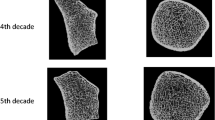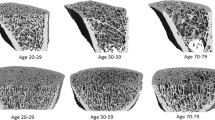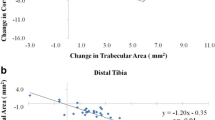Abstract
Summary
The rate of change in bone density was not different between peri- and post-menopausal women. Differences in rate of change were observed in bone microarchitecture, specifically cortical porosity (Ct.Po), where peri-menopausal women increased +9% per year compared with the +6% per year for post-menopausal women.
Introduction
The purpose of this study was to compare changes in bone density and microarchitecture in peri- and post-menopausal women over 6 years.
Methods
Peri- (n = 26) and post- (n = 65) menopausal women were selected from the Canadian Multicenter Osteoporosis Study. Caucasian women were scanned on dual x-ray absorptiometry (DXA) and high-resolution peripheral quantitative computed tomography (HR-pQCT) at baseline and follow-up, an average 6 years later. To compare repeat scans, automated 3D image registration was conducted. At the radius and tibia, total volumetric BMD (Tt.BMD), total bone area (Tt.Ar) and cortical porosity (Ct.Po) were assessed, and finite element analysis estimated apparent bone strength.
Results
At the tibia, the rate of change for Ct.Po and Tt.Ar was different between groups. Peri-menopausal women had a + 9% per year increase in Ct.Po, but this increase was slower for post-menopausal women at +6% per year (p = 0.049). In addition, post-menopausal women had an increase in Tt.Ar of +0.13% per year compared with a slower increase of +0.06% per year for peri-menopausal women (p = 0.017). The rate of change of density between groups was not significantly different and was approximately −1% per year at the hip by DXA, and −1% per year at the radius and −0.5% per year tibia by HR-pQCT.
Conclusion
This is a 6-year prospective HR-pQCT study exploring rate of change in Caucasian peri- and post-menopausal women. The microarchitectural features represented by Ct.Po and Tt.Ar changed at a significantly different rate between groups, but group differences were not detected by density measures.

Similar content being viewed by others
References
Greendale GA, Lee NP, Arriola ER (1999) The menopause. Lancet 353:571–580. doi:10.1016/S0140-6736(98)05352-5
Xu J, Bartoces M, Neale AV et al (2005) Natural history of menopause symptoms in primary care patients: a MetroNet study. J Am Board Fam Pract 18:374–382. doi:10.3122/jabfm.18.5.374
Finkelstein JS, Brockwell SE, Mehta V et al (2008) Bone mineral density changes during the menopause transition in a multiethnic cohort of women. J Clin Endocrinol Metab 93:861–868. doi:10.1210/jc.2007-1876
Arlot ME, Sornay-Rendu E, Garnero P et al (1997) Apparent pre-and postmenopausal bone loss evaluated by DXA at different skeletal sites in women: the OFELY cohort. J Bone Miner Res 12:683–690. doi:10.1359/jbmr.1997.12.4.683
Soda M-Y, Mizunuma H, Honjo S-I et al (1993) Pre- and postmenopausal bone mineral density of the spine and proximal femur in Japanese women assessed by dual-energy X-ray absorptiometry: a cross-sectional study. J Bone Miner Res 8:183–189. doi:10.1002/jbmr.5650080209
Warming L, Hassager C, Christiansen C (2002) Changes in bone mineral density with age in men and women: a longitudinal study. Osteoporos Int 13:105–112. doi:10.1007/s001980200001
Chapurlat RD, Garnero P, Sornay-Rendu E et al (2000) Longitudinal study of bone loss in pre- and perimenopausal women: evidence for bone loss in perimenopausal women. Osteoporos Int 11:493–498. doi:10.1007/s001980070091
Guthrie JR, Ebeling PR, Hopper JL et al (1998) A prospective study of bone loss in menopausal Australian-born women. Osteoporos Int 8:282–290. doi:10.1007/s001980050066
Kanis JA (2002) Diagnosis of osteoporosis and assessment of fracture risk. Lancet 359:1929–1936. doi:10.1016/S0140-6736(02)08761-5
Macdonald HM, Nishiyama KK, Kang J et al (2011) Age-related patterns of trabecular and cortical bone loss differ between sexes and skeletal sites: a population-based HR-pQCT study. J Bone Miner Res 26:50–62. doi:10.1002/jbmr.171
Boutroy S, Bouxsein ML, Munoz F, Delmas PD (2005) In vivo assessment of trabecular bone microarchitecture by high-resolution peripheral quantitative computed tomography. J Clin Endocrinol Metab 90:6508–6515. doi:10.1210/jc.2005-1258
Nishiyama KK, Macdonald HM, Buie HR et al (2010) Postmenopausal women with osteopenia have higher cortical porosity and thinner cortices at the distal radius and tibia than women with normal aBMD: an in vivo HR-pQCT study. J Bone Miner Res 25:882–890. doi:10.1359/jbmr.091020
Kreiger N, Tenenhouse A, Joseph L et al (1999) The Canadian multicentre osteoporosis study (CaMos): background, rationale, methods. Can J Aging 18:376–387
Tenenhouse A, Kreiger N, Hanley D (2000) Canadian multicentre osteoporosis study (CaMos). Drug Develop Res 49:201–205. doi:10.1002/(SICI)1098-2299(200003)49:3<201::AID-DDR10>3.0.CO;2-O
Burt LA, Macdonald HM, Hanley DA, Boyd SK (2014) Bone microarchitecture and strength of the radius and tibia in a reference population of young adults: an HR-pQCT study. Arch Osteoporos 9:183–189. doi:10.1007/s11657-014-0183-2
MacNeil JA, Boyd SK (2008) Improved reproducibility of high-resolution peripheral quantitative computed tomography for measurement of bone quality. Med Eng Phys 30:792–799. doi:10.1016/j.medengphy.2007.11.003
Pauchard Y, Liphardt A-M, Macdonald HM et al (2012) Quality control for bone quality parameters affected by subject motion in high-resolution peripheral quantitative computed tomography. Bone 50:1304–1310. doi:10.1016/j.bone.2012.03.003
Buie HR, Campbell GM, Klinck RJ et al (2007) Automatic segmentation of cortical and trabecular compartments based on a dual threshold technique for in vivo micro-CT bone analysis. Bone 41:505–515. doi:10.1016/j.bone.2007.07.007
Burghardt AJ, Buie HR, Laib A et al (2010) Reproducibility of direct quantitative measures of cortical bone microarchitecture of the distal radius and tibia by HR-pQCT. Bone 47:519–528. doi:10.1016/j.bone.2010.05.034
Pistoia W, van Rietbergen B, Laib A, Rüegsegger P (2001) High-resolution three-dimensional-pQCT images can be an adequate basis for in-vivo μFE analysis of bone. J Biomech Eng 123:176–183. doi:10.1115/1.1352734
MacNeil JA, Boyd SK (2008) Bone strength at the distal radius can be estimated from high-resolution peripheral quantitative computed tomography and the finite element method. Bone 42:1203–1213. doi:10.1016/j.bone.2008.01.017
Pistoia W, van Rietbergen B, Lochmüller EM et al (2002) Estimation of distal radius failure load with micro-finite element analysis models based on three-dimensional peripheral quantitative computed tomography images. Bone 30:842–848. doi:10.1016/S8756-3282(02)00736-6
Ahlborg HG, Johnell O, Nilsson BE et al (2001) Bone loss in relation to menopause: a prospective study during 16 years. Bone 28:327–331. doi:10.1016/S8756-3282(00)00451-8
Sowers M, Crutchfield M, Bandekar R et al (1998) Bone mineral density and its change in pre- and perimenopausal white women: the Michigan bone health study. J Bone Miner Res 13:1134–1140. doi:10.1359/jbmr.1998.13.7.1134
Greendale GA, Sowers M, Han W et al (2012) Bone mineral density loss in relation to the final menstrual period in a multiethnic cohort: results from the Study of Women’s Health Across the Nation (SWAN). J Bone Miner Res 27:111–118. doi:10.1002/jbmr.534
Guthrie JR, Dennerstein L, Taffe JR et al (2010) The menopausal transition: a 9-year prospective population-based study. The Melbourne Women's Midlife Health Project Climacteric 7:375–389. doi:10.1080/13697130400012163
Tenne M, McGuigan F, Besjakov J et al (2013) Degenerative changes at the lumbar spine—implications for bone mineral density measurement in elderly women. Osteoporos Int 24:1419–1428. doi:10.1007/s00198-012-2048-0
Recker R, Lappe J, Davies K, Heaney R (2000) Characterization of perimenopausal bone loss: a prospective study. J Bone Miner Res 15:1965–1973. doi:10.1359/jbmr.2000.15.10.1965
Shanbhogue VV, Brixen K, Hansen S (2016) Age- and sex-related changes in bone microarchitecture and estimated strength. A three-year prospective study using HRpQCT. J Bone Miner Res 31:n/a–n/a. doi: 10.1002/jbmr.2817
Recker R, Lappe J, Davies KM, Heaney R (2004) Bone remodeling increases substantially in the years after menopause and remains increased in older osteoporosis patients. J Bone Miner Res 19:1628–1633. doi:10.1359/JBMR.040710
Riggs BL, Melton LJ, Robb RA et al (2008) A population-based assessment of rates of bone loss at multiple skeletal sites: evidence for substantial trabecular bone loss in young adult women and men. J Bone Miner Res 23:205–214. doi:10.1359/jbmr.071020
Ahlborg HG, Johnell O, Turner CH et al (2003) Bone loss and bone size after menopause. N Engl J Med 349:327–334. doi:10.1056/NEJMoa022464
Kawalilak CE, Johnston JD, Olszynski WP, Kontulainen SA (2014) Characterizing microarchitectural changes at the distal radius and tibia in postmenopausal women using HR-pQCT. Osteoporos Int 25:2057–2066. doi:10.1007/s00198-014-2719-0
Berger C, Langsetmo L, Joseph L et al (2008) Change in bone mineral density as a function of age in women and men and association with the use of antiresorptive agents. Can Med Assoc J 178:1660–1668. doi:10.1503/cmaj.071416
Seifert-Klauss V, Fillenberg S, Schneider H et al (2012) Bone loss in premenopausal, perimenopausal and postmenopausal women: results of a prospective observational study over 9 years. Climacteric 15:433–440. doi:10.3109/13697137.2012.658110
Acknowledgements
The authors would like to thank all the participants who graciously devoted time to participate in the study, Anne Cooke and Taryn Harris for the scan acquisition, Duncan Raymond for recruitment and scan analysis, and Jane Allan and Bernice Love for their assistance in participant recruitment and administering the extensive interview-based questionnaire.
This study was funded by the Canadian Institutes of Health Research (CIHR) MOP-106611.
Author information
Authors and Affiliations
Corresponding author
Ethics declarations
Informed consent was obtained from all individual participants included in the study, and the University of Calgary’s Conjoint Health Research Ethics Board approved all protocols.
Conflicts of interest
None.
Rights and permissions
About this article
Cite this article
Burt, L.A., Bhatla, J.L., Hanley, D.A. et al. Cortical porosity exhibits accelerated rate of change in peri- compared with post-menopausal women. Osteoporos Int 28, 1423–1431 (2017). https://doi.org/10.1007/s00198-016-3900-4
Received:
Accepted:
Published:
Issue Date:
DOI: https://doi.org/10.1007/s00198-016-3900-4




